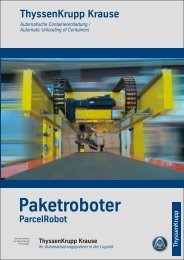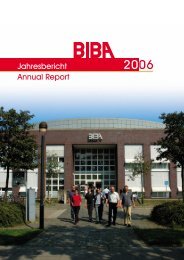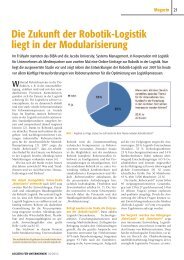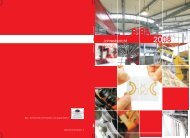Jahresbericht 2009 - Biba - Universität Bremen
Jahresbericht 2009 - Biba - Universität Bremen
Jahresbericht 2009 - Biba - Universität Bremen
Sie wollen auch ein ePaper? Erhöhen Sie die Reichweite Ihrer Titel.
YUMPU macht aus Druck-PDFs automatisch weboptimierte ePaper, die Google liebt.
Learning pallets as feasible autonomous logistics objectsBasically, the autonomy paradigmis introduced to handle and reducecomplexities that accompanydynamic authorized environments.Since production systems and logisticsprocesses are always subject todynamic changes, they are suitablefor employing autonomous controlinto their operations. The correlationof production and logistics systemswith humans, i.e., as members of thesystem and as the end customer,exposes them to continuous changes,internal or external.A new approach to getting alongwith such systems is to be in balancewith the changes: Normally, livesystems do not oppose environmentalchanges, they just adapt to thecurrent situation. Adoption of dynamicsinto own performances bringssustainability as well as effectiveness.Members of a society have the autonomyto make decisions based ontheir knowledge and local information;their interactions lead to sustainablesocieties.Inspired by this novelty, productionsystems have tried to adopt autonomy,so that the complexities of controllingan entire system are moderated.On the other hand, by bringingenough flexibility to the system, theycope with dynamic markets andprocesses. Shifting from a conventionalcentral system with a hierarchicalstructure to a flexible decentralizedone with a heterarchical structuresupports this perspective.Furthermore, in the range of strategiesfor material flows in logisticsnetworks, pull systems seem morecompatible with the characteristicsand objectives of autonomouslogistics systems. Actually, the pullconcept requires the decentralizedcontrol of material flow to evadepush disadvantages.Practically, pallets, box pallets, andcontainers could be considered asloading equipment for pulling materials.In pull-systems they circulate in aclosed-loop system (e.g., shop-floorsor between members of a network)and carry the ordered materials fromthe point of production to the point ofconsumption. The products themselvesleave the system, but the palletsremain as parts of the system for awhile. They can act like Kanbans tocontrol the smooth flow of materials.These attributes brought the idea ofintelligent pallets, as a feasible featureof autonomous logistics objects.Considering the advantages of autonomouscontrol, intelligent palletsare able to meet the requirementsof pull systems and simultaneouslydeal with fluctuations in demand andprocesses. Because of their closedloopflow, they have the capability tolearn from the very recent cycles andeven predict near future conditions.These pallets could even be ableto operate proactively by avoidingpotential malfunctions and inflexibilitywhilst improving responsivenessof the system. This learning aptitudebrings the innovative idea of learningpallets, whose intrinsic attribute is itsflexibility in dealing with changes.State of the art technologies, likeRFID and wireless sensor networks, arethe suitable components for puttingthis idea into practice in an efficientand effective manner. However, concerningthe complexities of productionplanning and control tasks, whichmostly deal with non-linear behaviors,the chosen planning and controllingmethodologies must be practical.Exactly this transformation is the topicof a thesis at the International GraduateSchool for Dynamics in Logistcs,funded by the Kieserling-Stiftung.Afshin Mehrsai33









